

Home » Over the Alps in a rickshaw: a chat with Bill Phelps
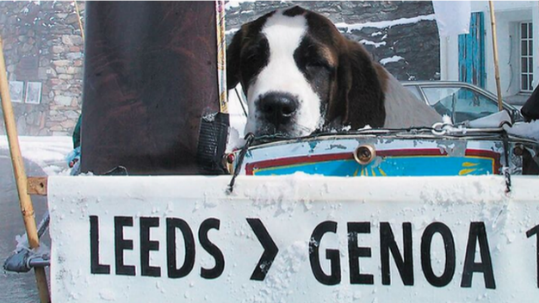
In part 1 of our Cycling Champions series we spoke to Amanda Sowerby, who helped to deliver Sustrans’ UTravelActive project in Leeds. For part 2, Chris spoke to Bill Phelps, a man who holds the proud accolade of having ridden a rickshaw over the Alps to Genoa to join the G8 protests in 2001.
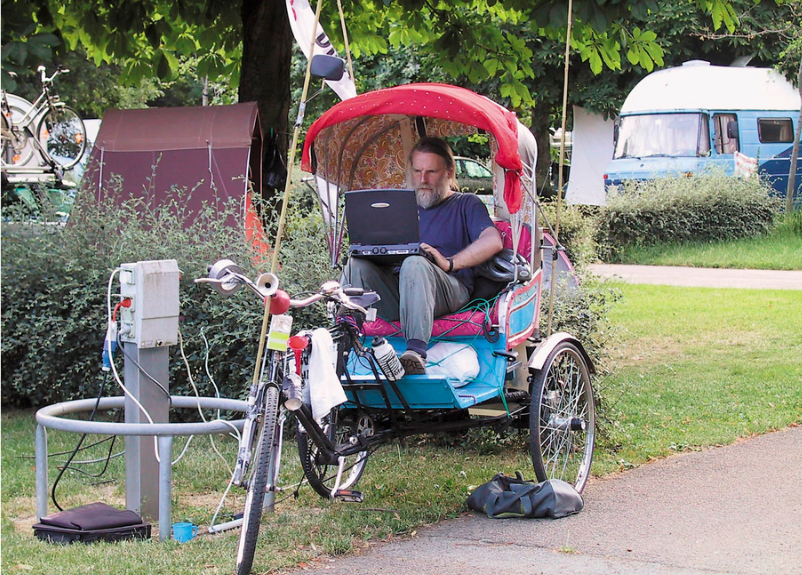
Bill welcomes me into his home and I add my bike to the bunch already in the hall, one of which is quite garish: its entire frame is a sort of makeshift collage, complete with a row of photograph faces along the top tube. “My son designed it to make it as ugly as possible to stop people stealing it”, he explains – an early indicator of a relaxed and refreshing attitude to cycling.
I planned to ask Bill the same questions I asked Amanda, leading to some sort of consistency in the Cycling Champion series, but with the twin elephants of a customised rickshaw and the highest mountain range in Europe sitting in the room it quickly became apparent that a new set would be necessary!
The opener stayed the same, however: what got you into cycling?
“I’ve never been sporty”, he answered, “but I’ve always seen the bicycle as a very practical way of getting around. When I was about 12 I did a two day trip with a friend, but between that and the first rickshaw ride in 1998, I did no touring at all.
 “I was working as a graphic designer for the Jubilee 2000 project in the late 90s, and my contact there was telling me about the organisation’s attempt to attract people on as many forms as transport as possible – someone was coming via canal in a coracle – and I realised that I might just be able to get my hands on an Indian cycle rickshaw.
“I was working as a graphic designer for the Jubilee 2000 project in the late 90s, and my contact there was telling me about the organisation’s attempt to attract people on as many forms as transport as possible – someone was coming via canal in a coracle – and I realised that I might just be able to get my hands on an Indian cycle rickshaw.
“That’s what started the thought process really: after that I rode a rickshaw to the G8 in Birmingham 1998, Cologne in 1999, and to Genoa in 2001. I think if there was a time I got ‘the long-distance cycling bug’, it would be the 1998 ride.”
Boasting 1206.9 miles and thousands of feet of elevation (the exact figure is sadly lost to history), the ride to Genoa is a truly fearsome undertaking. Add to that a group of mixed ability riders ranging from an 18 year old newbie to a seasoned 72 year old, and a 100kg rickshaw (the average bike weighs around 8kg..!) and it becomes the stuff of adventure.
I ask Bill where he acquired an Indian rickshaw, and how he readied it to make the transition from short journeys on flat roads to an undulating and transcontinental European trek.
“That first trip – to the Birmingham G8 – was on a rickshaw borrowed from a company that did tourist trips around York. A few months later we were on a family holiday in India, so I called in at a rickshaw factory in Chennai and arranged for one to be shipped to the UK. We’d had so much fun on the Birmingham ride that we were already planning for next year’s Cologne trip.”
“For the Genoa ride, the first change I made was to the brakes. The existing ones were designed for flat Indian roads, not long downhill sections, so I added a new disc brake to one of the rear wheels to supplement built two new brake systems additional to the calliper brake already on the front wheel and the pedal-operated drum brake on the back axle – each brake was controlled by a separate mechanism!
“There were no gears at the start either, so I got hold of a rare 1950s four-speed Sturmey-Archer hub gear to increase the rickshaw’s versatility.”
An article from the December 2001 VeloVision magazine, which Bill lent me as extra research material, describes the disc brake wonderfully as an “extra concession to modernity”. I’d argue it’s more of a “necessity for the rider’s sanity” – when asked about how it performed, Bill said he “felt comfortable with the extra brake”, although he opted to take the rickshaw down the hills.
At first I wondered whether this was chivalry in action or just a desire to bagsy the downhill sections; when he mentioned the necessity of stopping every few hundred yards to pour water on the brakes to prevent them from overheating, it confirmed the former.
“I also opted to test the emergency brake system before it became necessary, which involved running the back wheel into a mound of snow at the side of the road. The prediction was that it would stop the rickshaw: in practice it did, but the mechanical stresses also broke 3 spokes on the opposite wheel!”
Some other tweaks were made to the rickshaw before it was road ready including a crude inclinometer (“it was a stone pendulum that shows whether you’re travelling up or down. In case you couldn’t tell”) and, at one point, a vice was attached to the frame. It’s unclear whether this was for aesthetic purposes, structural integrity, or some other purpose; some questions are best left unanswered.
Often the weighty rickshaw would be pushed from behind by one cyclist on each side to reduce the burden on the rider. “When we became more confident, we’d use a Canada Geese formation and have a row of 3 cyclists on each side pushing the rickshaw and each other. This took up the whole road, so we tended not to do it too often”, he explains candidly.
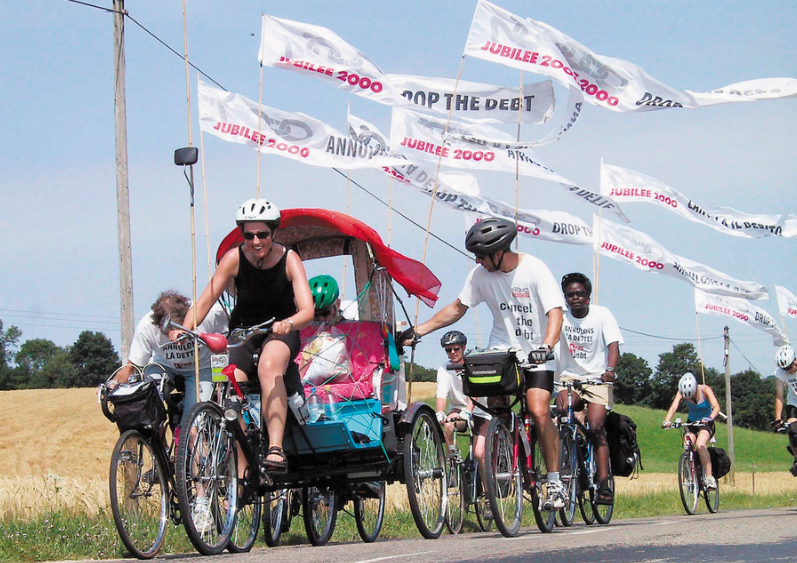
“There was something medieval about the imagery of us riding with flags, and it was quite striking from a distance”, Bill explains. Various police officers along the route evidently thought the same thing: “we didn’t tell any authorities about our ride, but they managed to intercept us en route where they felt it necessary. There was no trouble but some suspicion, especially when we hit the Swiss hills: the local traffic police and their Swiss authoritarianism really didn’t take well to us.”
There’s a great snippet in aforementioned VeloVision article to this effect:
“The rickshaw was stopped by a grumpy policeman who was searching for a reason to frustrate this manifestation of dangerous English eccentricity. “Ce n’est pas normale” was the best he could suggest but, fortunately, failure to be normal doesn’t quite amount to grounds for arrest in Swiss law.
It’s always interesting hearing about the different ways locals (and local constabularies) respond to cycle tourists of various ilks. It sounds like the reception was positive, if not slightly bemused. Was this the case throughout?
“Sometimes these interruptions felt more menacing than others. The Carabinieri, so called because of their famous use of Carbine rifles, often followed and escorted us around cities as they were expecting trouble from protesters” – this later came tragically to a head with a fatal shooting at the protest itself.
“It wasn’t all bad, though. In one city, a big black car with tinted windows arrived and the Mayor of the town stepped out and posed with us for photos. The local police then escorted us to the campsite, and later offered us a guided tour of the town in their police car. It turned out that this region had left leaning politics as opposed to the country’s trend to the right at the time, and this mayor’s act was a gesture of solidarity and acknowledgement of the Carabinieri’s opposing attitude.”
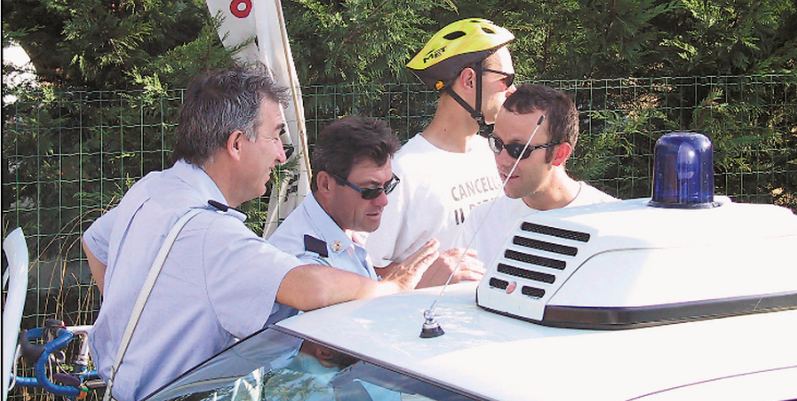
The locals were almost always receptive and well-wishing though. Bill recounts one story where some old ladies waved down the group and invited them into their house for tamarind tea (“refreshing, thick and brown, although I wouldn’t go out of my way to try it again”). “We didn’t share a language but they wanted to encourage us and show their support” – this type of behaviour was commonplace.
“Thanks to a combination of our efforts before leaving and word-of-mouth, the media frequently found us en route for ad hoc interviews and photo-shoots.”
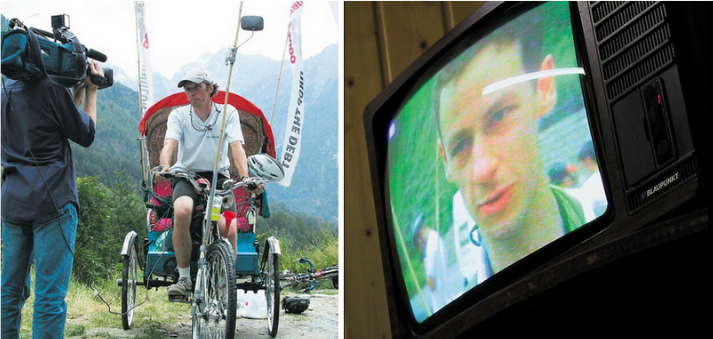
Left: the rickshaw rider smiles for the camera. Right: a local news program shows an interview, viewed from a hostel
Sometimes the interfering authorities would send the rickshaw and accompanying entourage along alternate routes, “diversions onto steeper, hillier, but prettier roads that most people don’t get to see”. How did you plan the route?
“We had two navigators for the trip, one of whom really enjoyed hills. He would tailor the route to encounter them” – this struck me as particularly sadistic – “and would read maps and alter the route whilst riding”. “We did explore the idea of going around the Alps, but the increase in distance meant it wasn’t worth it, and we wanted the glory of the St Bernard pass” (home of the monks who breed the eponymous dogs).
To fit with riders’ commitments and schedules, the ride was broken down into 43 legs:
“We rode down the UK over two bank holiday weekends and another weekend. We rode from Leeds to Peterborough at the start of May (3 days), Peterborough to South London at the end (also 3 days), and then completed the UK legs of the ride from South London to Folkestone (2 days). The rickshaw was left locked in various garages along the way.
“To start the final, main leg, we took a ferry to Calais on 30th June, then spent 3 weeks pedalling to arrive in Genoa on 20th July: one day ahead of schedule. We had rest days in Paris, Dijon and Martigny (near the top of the ascent). These largely consisted of the blokes mending their bikes and the women washing theirs. A familiar site on these days was bodies of collapsed cyclists scattered about”
“We aimed for around 50 miles a day, although on the days when the navigators were taking time off, our search for quiet roads often led to lengthy ‘detours’, sometimes taking us to around 80 miles. Rest stops were numerous and often looked like accident scenes, with bodies of collapsed cyclists scattered about”
“We set up some of the accommodation up in advance, mainly via the internet with organisations whose interests were in line with ours. We stayed in churches, monasteries, etc. Often our hosts would cook us breakfast in solidarity: it was a pleasant arrangement.”
Convincing people to join at 1,200 mile ride over mountains is a surprisingly tricky task – I asked Bill about how he managed to convince people to join on this undertaking.
“It was largely a family and friends affair, and we were joined by others who got the vision – including a professor, a GP and a midwife. Just in case”, Bill explains with a smile – “we were ready for anything!
When discussing the ensemble, his motivations for the ride become clearer and it paints a nice picture: “while the rickshaw was good for getting attention, the thing I’m most proud of is having attracted beginner cyclists and spreading the cycling bug: my daughter came along and she had never cycled more than 10 miles in one go before that year, so it was a completely new thing to her, and most of the riders still cycle today and we all remember the ride fondly
“We actually had a rival team, too, led by councillor Roger Harington, who we dubbed the “Lycra cyclists”. They were keen on getting there quickly, although we managed to beat them there (albeit with a head-start): we saw them arriving from the roof of a nun-filled convent we were staying in.”
Did you have a training regime in place to bring the cyclists up to a suitable standard?
“We did look for steep hills to train on, although this turned out to be unnecessary: as the maximum gradient on the mountain passes was determined by Napoleon on their construction as allowing a gun carriage to cross and they aren’t actually that steep.
“The main goal of the training was teaching people how to use the rickshaw: if you’re used to riding a regular bicycle you’ll attempt to balance and lean into steering, whereas this is redundant on the rickshaw. We had to rewire these hard-wired responses to prevent people from steering off the road and into bushes, or even into oncoming traffic.
“The training proved useful, and we helped each other out. One day when crossing the Poe Valley in Italy, cycling into a headwind, we tucked our 72 year old rider right behind the rickshaw so she was protected from the wind. She was riding blind but we made it!” – Bill mentions the camaraderie as being one of the best parts of the ride: a sentiment we definitely share!
After such an odyssey to get there, Bill explains how “it was actually a bit of an anticlimax” arriving at the host city for the G8 summit: “there were some troublemaker elements in the protests, so the organiser actually called off the march. We followed an unofficial route for a while, but seeing a combination of smoke in the distance and some shady characters in the crowd, and being laden with bikes, we decided not to join the main gathering and peeled away from the group.”
“In the end we had zero effect on the G8, but we did have an effect on lots of people en route, raising awareness of the issues, which we count as a success”
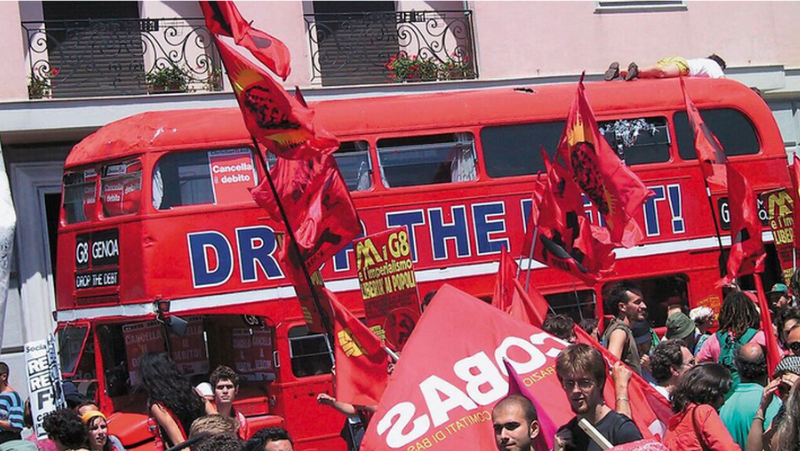
The troublemaker element Bill mentioned seems to be a constant at all protests. A small fraction of anarchists and hooligans whose aim is to cause damage and who, without fail, capture the attention of the media and skew the public perception of the event. There were around 200,000 protesters, the majority of whom were peaceful, but history remembers the negative elements.
Bill’s friend Tim Harberd, the founder of Leeds Cycling Action Group (now the Leeds Cycling Campaign), enjoyed the challenge of riding it back solo. Bill summarised his efforts: “he’d wake up at dawn, ride until lunch, steal an hour’s sleep under the rickshaw, then continue riding until dusk.” He had “legs like tree trunks”; presumably he’s also bionic.
“He got back quicker than our group took to get there, and he really ought to have got into the Guinness Book of Records for the effort”. Sadly there is no relevant category however, “which is ridiculous, as the rickshaw is a hugely established form of transport in some parts of the world. In Bangladesh at the time, for example, rickshaws annually transported more freight than lorries”.
Asking Bill about the best bits and lingering memories of the ride revealed familiar sentiments: “the sense of achievement, the sense of pilgrimage, and the bonding. There’s something about overcoming problems together: when you’re worn out, despairing and feeling like giving up, but still managing to get there. The sense of camaraderie is incredible. The trip to Genoa has genuinely been one of the most exciting things I’ve done in my life. It felt like we were there to change the world.”
To finish, I asked Bill how he would pitch cycling to a newbie in 20 words or less:
It’s a great way of getting around. Probably about the only vehicle where the engine gets stronger the more you use it. Something like that!
(That’s 25 words, but we’ll allow it.)
Bill is on the board of Tidal, a campaigning organisation aiming to connect various activist groups in and around Leeds. They are organising a fundraising ride in June which you can donate to here.
All pictures in this post were taken by Bill and are used with permission.


Leave a Reply